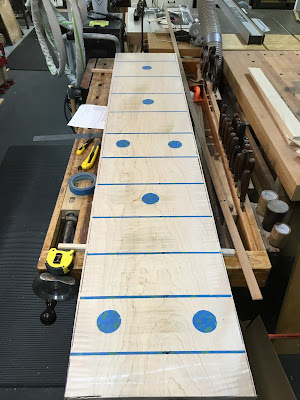 |
| My "Fretboard Bench" and Koa 000-14 #5 |
Instrument building phase complete Dave...
Probably more than 10 years ago, for a number of reasons, I chose to build a guitar. And as so often happens with my interests, it exploded into a full-on instrument building phase of my woodworking journey. When it was all over I had managed to complete 10 acoustic guitars, a Benedetto-style archtop, a couple of mandolins, and a few electric guitars and basses. Once this challenge was met and I felt I had achieved all I could with it, I stored my jigs and tools away to move back to furniture and other assorted undertakings.The one key take-away I have from my instrument-building journey is that the level of precision and attention to detail necessary to build good instruments was well beyond where my skills were at the time. Today I have a better appreciation for what is necessary to do work at the quality that I can be proud of. I continue to tell my friends, if you want to take your woodworking to the next level, build an acoustic guitar, you will not be disappointed.
At the end of last year, I realized it was time to move out the dormant instrument building tools & jigs to make room in the shop. I got in touch with a young guy nearby who was starting up a luthiery business and we worked out a deal that worked for both of us, and I was officially out of the instrument-building business. I had given a few of the guitars I made to friends and family and kept the rest.
I did however, have one last music-inspired project I had planned to build and this Spring I made the move. I have not done a lot of mixed media projects in the past, but to achieve the effect I was after, I needed to do so. I chose aluminium as the metal of choice as it was easy to work with woodworking tools, it is lightweight and the colour worked for my purpose. The project was a bench which would look like the fretboard of guitar. I had purchased the curly maple board for this purpose about three years ago and had been stepping over it ever since.
 |
Fretboard Bench
The bench is made from soft curly Maple with aluminum "frets" and legs. Side dots and fret markers are Cocobolo.
|
The build of this was an interesting exercise as I had a very specific picture in my mind of the final product and needed help to achieve it. My buddy Joey the machinist would make the aluminium base and another friend in the metals business got me the aluminium strips for the "frets". Here's the studio shots of the finished project, followed by a few shop shots chronicling the build.
 |
| I put red lines on the bottom of the long slots to help show up the depth to remove. My jackplane removed the planer marks and started to establish a flattish surface for the seat. |
 |
| Once the top was more or less smooth I fitted each of the aluminum strips into their slot and radiused them on the bandsaw to minimize the material I would need to remove. |
 |
| The frets were epoxied in and the cocobolo dots inlaid before the sanding phase. |
 |
| Using a shop-made sanding block I spent several hours removing high spots and getting the smooth top I needed. |
 |
| Final sanding with the ROS up to 400 grit gave a glass smooth top and textured the aluminum to a matte finish. |
 |
| A few coats of my goto finish of Watco Danish Oil natural makes the figure in the maple pop. |









